Last Updated: November 18, 2008
- Introduction
- The Search Page
- Searching
- Searching by Fields
- Author Name Searching
- Corporate Author Searching
- Title Searching
- MeSH Searching
- Boolean Operators
- Allowable Search Fields Descriptions and Tags
- Search Limits and Settings
- English Only Limit
- Subsets
- Publication Date Limit
- Results
- Results Categories
- Results Summary
- Results Page
- Navigation
- Display Formats
- Download or Display
(Note: Includes Display in Browser, Printing, and Saving)
- Send via e-mail
- Document Ordering
- Search History
- Term Finder
- Locker
- Sign in
- For More Assistance
- Customer Support
- NLM Publications on the Gateway
- Gateway Training
- Linking to the Gateway
- System Configuration
-
Gateway Data Elements by Collection
(Print hint: Open and print this link separately)
-
Display Formats Data Elements by Collection
(Print hint: Open and print this link separately)
-
Allowable Search Fields by Collection
(Print hint: Open and print this link separately)
Introduction
The NLM Gateway allows you to search in multiple retrieval systems
(databases) at the U.S. National Library of Medicine (NLM) from a single
interface, providing "one-stop searching" for many of NLM's information
resources. It is being developed by the
Lister Hill National Center
for Biomedical Communications (LHNCBC) at the
U.S. National Library of Medicine
(NLM), part of the U.S. National
Institutes of Health (NIH). The Gateway Overview
has more information.
The Search Page
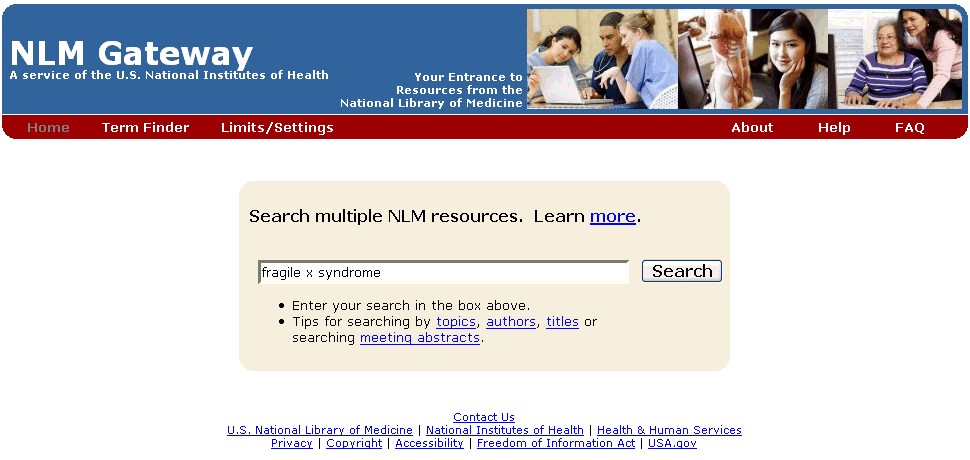
- The Gateway search box is at the top of each page.
- The Gateway Features bar includes
Term Finder, Limits/Settings, Search Details, History, My Locker, About, Help, and FAQ.
- The Gateway bottom bar contains Contact Us and administrative links.
Searching
Enter search terms in the query box.
Click on "Search" or hit "Enter".
|
|
The query box is on every page. You do not need to
return to the home page to enter a new search.
- The default is a subject search.
- Enter one or more search terms in the query box and click on
"Search" or hit "Enter".
- The maximum length for user input is five hundred (500) characters.
- Search terms are automatically combined (ANDed) together.
- Unqualified terms map to Medical Subject Headings (MeSH) terms
or Supplementary Concept terms when appropriate to provide more
comprehensive results (e.g, heart attack maps to myocardial
infarction). Myocardial Infarction is searched as a MeSH term in addition
to heart attack being searched as text words.
- A spell checker is applied to some search queries. If a term is not
recognized, the user is alerted to a possible misspelling, and is given the option
to choose an alternate spelling and rerun the search.
- Gateway ignores stopwords in subject search queries that are not part of
a phrase. There are six stopwords in the Gateway: a, an, and, not, or, the.
PubMed, ClinicalTrials.gov, and DIRLINE: Directory of Health Organizations have
separate stopword lists. Other collections do not have a stopword list.
Searching by Fields
- Field qualifiers should be entered after the search
term or terms.
- Must be in square brackets.
- May be upper or lower case.
- Unqualified terms should be entered after all qualified terms,
or should be separated with a Boolean operator (AND, OR, NOT).
Examples:
vitamin C [MH] AND common cold
lead screening [TW] children
lymphedema/therapy [MH] AND 2004:2006 [DP]
quality of life [TI] prognosis [MH]
Notes:
- The Allowable Search Field Descriptions and Tags section
below lists allowable field
qualifiers.
- A table of all collections and the
allowable search fields is available.
Author Name Searching
Enter last name plus initials (no punctuation), followed by [AU]
Rockson SG [AU]
Demner-Fushman D [AU]
Smith R 3rd [AU]
|
|
- You may search for multiple authors at one time.
- You may enter only the last name, or the last name and
the first initial if you do not know the middle initial.
The Gateway will truncate initials for the following collections:
PubMed, NLM Catalog, Meeting Abstracts, and HSRProj.
(e.g., Smith D [au] will retrieve Smith DA, Smith DB, etc.)
Examples:
Harris MI [AU]
Charron-Prochownik D [AU] Siminerio LM [AU]
Ferris FL 3rd [AU]
Kovacs [AU]
Kovacs [AU] AND ritonavir [TI]
Harris MI [AU] AND Diabetes Mellitus [MH]
Notes:
- You can search for HSRProj investigators using the author field
qualifier.
- HSRProj investigator names are displayed as full names, but
must be searched in the format last name plus initials
(no punctuation).
- The following collections do not have authors:
- Bookshelf
- all MedlinePlus collections
- ClinicalTrials.gov
- DIRLINE: Directory of Health Organizations
- Genetics Home Reference
- Household Products Database
- HSDB: Hazardous Substances Data Bank
- IRIS: Integrated Risk Information System
- ITER: International Toxicity Estimates for Risk
- GENE-TOX: Genetic Toxicology (Mutagenicity)
- CCRIS: Chemical Carcinogenesis Research Information System
- Profiles in Science
- If you search for only an author name, collections without authors
will not be searched.
- If an author is part of a larger search query, the author portion
of the search will be ignored by collections without authors, and the
remainder of the search will be accomplished in these collections
(e.g., Pauling L [AU] vitamin c will be searched as vitamin c).
Corporate Author Searching
- To search for a particular corporate author, enter the corporate author
followed by the field qualifier [CN].
- You may search for multiple corporate authors at one time.
Examples:
International Conference on Aids [CN]
Cochrane Colloquium [CN]
Conference on Retroviruses and Opportunistic Infections [CN] AND HOPS [CN]
International Society of Technology Assessment in Health Care. Meeting [CN] AND 2003 [DP]
Conference on Retroviruses and Opportunistic Infections [CN] AND Wood K [AU]
Notes:
- The following collections do not have corporate authors:
- Bookshelf
- TOXLINE Subset
- DART: Developmental and Reproductive Toxicology
- all MedlinePlus collections
- ClinicalTrials.gov
- DIRLINE: Directory of Health Organizations
- Genetics Home Reference
- Household Products Database
- HSRProj
- OMIM: Online Mendelian Inheritance in Man
- HSDB: Hazardous Substances Data Bank
- IRIS: Integrated Risk Information System
- ITER: International Toxicity Estimates for Risk
- GENE-TOX: Genetic Toxicology (Mutagenicity)
- CCRIS: Chemical Carcinogenesis Research Information System
- Profiles in Science
- If you search for only a corporate author, collections without corporate
authors will not be searched.
- If a corporate author is part of a larger search query, the corporate
author portion of the search will be ignored by collections without corporate
authors, and the remainder of the search will be accomplished in these collections
(e.g., International Society of Technology Assessment in Health Care. Meeting [CN] AND 2003 [DP]
will be searched as 2003 [DP]).
Title Searching
Enter one or more title words followed by [TI]
AIDS [TI] sexually transmitted diseases [TI]
lyme disease [TI]
|
|
- You may enter a complete title, or one or more words or phrases found
in the title.
Examples:
AIDS [TI] sexually transmitted diseases [TI]
lyme disease [TI]
lyme disease [TI] AND France D [AU]
quality of life [TI] AND prognosis [MH]
Notes:
- A phrase may be present in the title of a PubMed journal citation,
but may not be on the list of recognized phrases used by PubMed.
If your title search of a phrase returns no results for PubMed,
you may wish to search the words individually.
MeSH Searching
The Medical
Subject Headings (MeSH) comprise NLM's controlled vocabulary
used for indexing articles, for cataloging books and other holdings, and
for searching MeSH-indexed databases, including MEDLINE. MeSH terminology
provides a consistent way to retrieve information that may use different
terminology for the same concepts.
- Enter the MeSH term followed by the field qualifier [MH].
- Enter the MeSH term followed by the
field qualifier [MJ] to search for a MeSH Major Topic.
- You may search for multiple MeSH terms at one time.
- To search for a MeSH term with one or more subheadings, enter
the MeSH term, a forward slash and one or more subheadings each
separated by a forward slash, followed by the field qualifier [MH] or [MJ].
- Enter subheadings in full (e.g, adverse effects),
or use the two character abbreviation (e.g., ae).
- Multiple subheadings for one MeSH term are ORed together (e.g., myocardial infarction/su/dt [MH]
is equivalent to myocardial infarction/su [MH] OR myocardial infarction/dt [MH]).
Examples:
Lyme Disease [MH]
Macular Degeneration/therapy [MJ]
Myocardial Infarction/su/dt [MH]
Lice [MJ]
Lyme Disease [MH] AND Antibodies, Bacterial [MH]
Lice [MJ] AND head [TI]
Notes:
- Drop parentheses from MeSH terms
(e.g., enter Earth (Planet) as earth planet [MH]).
- Entry terms are automatically mapped to MeSH terms.
- Automatic explosions are only valid for PubMed and NLM Catalog. MeSH
terms and MeSH major topics are not exploded in other collections.
- To turn off automatic explosion, enter the field qualifier followed by
":noexp" ([MH:noexp] or [MJ:noexp])
- To turn off mapping to the MeSH translation file so that a MeSH term
is searched as an exact MeSH phrase, enter the field qualifier followed
by ":nomap" ([MH:nomap] or [MJ:nomap]).
- Additional information about finding and selecting MeSH terms may be found
in the Term Finder section.
Note: The explosion of a MeSH term refers to the inclusion of more
specific MeSH terms indented under it in the MeSH hierarchy.
MeSH terms are arranged hierarchically by subject categories
with more specific terms arranged beneath broader terms.
MeSH organizes its descriptors in a hierarchical structure (MeSH Trees)
so that broad searches may include items indexed more narrowly.
More information on the structure of MeSH is available in the
Medical Subject Headings (MeSH®) Fact Sheet.
Information on subheadings may be found on the
Qualifiers page.
Boolean Operators
- The Boolean operators AND, OR, and NOT are available.
- Intersection (AND) - retrieves items that contain all the terms.
- Union (OR) - retrieves items that contain one or more of the terms.
- Difference (NOT) - excludes items that contain the term(s).
- The default operator is AND.
- Boolean operators AND, OR, NOT must be in upper case
(e.g., vitamin C OR zinc).
- The Gateway processes the AND and OR Boolean operators in a
left-to-right sequence.
- The NOT operator is processed first.
- Nesting: You can change the order in which the Gateway processes
the AND and OR operators in a search statement by enclosing the unit in
parentheses. The terms inside the set of parentheses will be processed
as a unit and then incorporated into the overall search strategy.
Examples:
common cold AND (vitamin C OR zinc)
hay fever AND (Loratadine OR Cetirizine)
Allowable Search Field Descriptions and Tags
Author [AU] - Enter the author name in the format last name plus initials (no
punctuation), followed by the field qualifier. Additional
information is in the
Author Name Searching section.
Corporate Author [CN] - Identifies the corporate authorship of an item.
Corporate names display exactly as they appear. Note:
MEDLINE Citations indexed pre-2000 and some citations indexed in 2000-2001
retain corporate authors at the end of the title field. For
comprehensive searches, consider including terms and/or words searched
in the title field [ti]. Additional information is in the
Corporate Author Searching section.
ISSN [IS] - International Standard Serial Number. It
may be entered with or without dashes (e.g., 00284793 [IS] or
0028-4793 [IS]).
Language [LA] - The language in which the item was published.
It may be entered in full (e.g., french [LA]) or using the three
character abbreviation (e.g., fre [LA]). The abbreviation
is normally the first three characters of most languages, with the most notable
exception being jpn for Japanese. Additional information about language
searching may be found in the English
Only Limit section.
MeSH Major Topic [MJ] - A MeSH term that is one of the main
topics discussed in the item. See MeSH Term below.
MeSH Term [MH] - To search for a MeSH term, enter the
MeSH term followed by the field qualifier. If a MeSH term or MeSH major
topic is entered, it will be automatically exploded in PubMed and NLM
Catalog only. For other collections, MH and MH:noexp and MJ and MJ:noexp
provide equivalent results. Additional information about MeSH searching
may be found in the
MeSH Searching section.
Publication Date [DP] - The date that the item was published.
Publication dates may be entered as a single date or a date range.
A date or date ranges must be searched using the format yyyy/mm/dd [DP]
(e.g., 2007/10/11 [DP]). To enter a date range, insert a colon (:) between
each date (e.g., 2005:2008 [DP]). Additional information about
publication date searching may be found in the
Publication Date Limit section.
Publication Type [PT] - The type of material the item
represents (e.g., Review, Clinical Trial, Retracted Publication,
Meeting Abstracts).
Subheading [SH] - Subheadings are used with MeSH terms
to help describe more completely a particular aspect of a subject.
A subheading may be entered in full (e.g., diet therapy [SH])
or using the two character abbreviation (e.g., DH [SH]).
Additional information about subheading searching may be found in the
MeSH Searching section.Information
on subheadings may be found on the
Qualifiers page.
Subject [SU] - This is the default Gateway search.
Subset [SB] - Limits a search to article citations on
specialized topics, or journal articles before 1966 (Oldmedline).
The following subject subsets are available: AIDS, Bioethics,
History of Medicine, and Space Life Sciences. To limit retrieval
to a particular subset, enter the subset value, followed by the
field qualifier. Valid subset values are aids, bioethics, history,
oldmedline, and space. Additional information about subset searching
may be found in the
Subsets Limit section.
Substance Name [NM] - The name of a chemical discussed in
the item. If an entry term is entered, it will be automatically mapped
to the substance name.
Text Word [TW] - Includes all words in the title, abstract,
MeSH terms, subheadings, and keywords. Please note that all
collections do not include all the above mentioned fields, and additional
fields may be searched for specific collections.
Title [TI] - Enter one or more title words
followed by the field qualifier. Additional information about title
searching may be found in the Title
Searching section.
Title Abbreviation [TA] - The journal title abbreviation.
If a journal name contains parentheses or brackets, enter the name
without the parentheses or brackets (e.g., J Hand Surg [Am] is entered
as J Hand Surg Am [TA]).
Unique Identifier [UI] - A unique identifier for an item.
PubMed IDs (PMIDs) may be searched using the Unique Identifier
field qualifier (e.g., 11054795 [UI] OR 11066716 [UI] OR 10422604 [UI]).
Notes:
- A table
of all collections and the allowable search fields is available.
Search Limits and Settings
- Use "Limits/Settings" on the Gateway Features bar to access
the Limits and Settings page.
- It allows you to customize your search limits, results settings, and
download and display options.
- If you have signed in and checked the "Use my limits/settings" checkbox,
your permanent limits will be the current settings.
- Limits will be in effect until they are turned off.
- To turn off limits, uncheck the checkbox.
- Use the Apply button to apply changes to your
current Gateway session only.
- Use the Save button to apply changes to your
current and future Gateway sessions.
- The Save button will overwrite any current limits or settings.
If using both the Save button and the Apply button, use the Save button first.
- You must sign in to save limits and settings.
Sign in requires a User ID and password. Registration is free.
- Use the Restore Default button to return permanent limits/settings
on the current page to the Gateway default settings.
- Use the Restore All Settings to Default button to return all limits/settings
to the Gateway default settings.
The different areas of the Limits and Settings page are shown below in four parts.

English Only Limit
- The Gateway default is to search all languages.
- Use the English only option to limit your search to English
language items only. This option excludes all foreign language items.
- Check the box, and select the Apply or Save button before
selecting the "Search" button.
Notes:
- This limit applies only to PubMed, TOXLINE Subset,
DART: Developmental and Reproductive Toxicology, NLM Catalog,
and Meeting Abstracts.
- This limit is ignored in the Related Articles function for PubMed.
Subsets
- The Gateway default is to search without any subset limits.
- Use the Subsets pull down menu to change the subset searched.
- Select the Apply or Save button before selecting the "Search" button.
Notes:
- The OLDMEDLINE for Pre1966 subset limit applies only to PubMed, and is ignored for
other collections.
- A subject subset limit applies only to PubMed, NLM Catalog, and Meeting Abstracts.
- A subject subset limit is ignored in the Related Articles
function for PubMed.
Publication Date Limit
- The Gateway default is to search all publication dates.
- Use the Publication dates (yyyy/mm/dd) from / to boxes to
limit your search to specific publication dates.
- One publication date or a range of publication dates may be searched.
- A publication date or date range must be searched using the format
yyyy/mm/dd (e.g., from 2007/12/01 to 2008/04/15). Months and days are
optional, and will be used only in searching PubMed.
All other collections will be searched for publication year only.
- The default ending publication year (if not specified by the user)
is the current year.
- Select the Apply or Save button before selecting the
"Search" button.
Notes:
- This limit applies only to PubMed, NLM Catalog, TOXLINE Subset,
DART: Developmental and Reproductive Toxicology, Meeting Abstracts, and HSRProj.
- This limit is ignored in the Related Articles function for PubMed.
- The maximum allowable ending publication year is the current year
plus ten years. For example, in the year 2008, the maximum allowable
ending publication year is 2018.
- You may limit by project years in HSRProj using the publication date
field qualifier. All intermediate years as well as the initial year and
the final year will be searched.
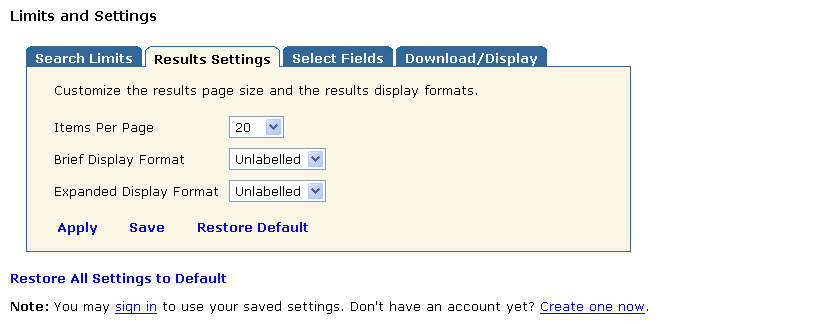
- Use the Items Per Page pull down menu to set the number of items
to be displayed on each page.
- Use the Brief Display Format pull down menu to select
labelled, unlabelled or export format for Brief Display.
- Use the Expanded Display Format pull down menu to select
labelled, unlabelled or export format for Expanded Display.
- Select the Apply or Save button before selecting the "Search" button.
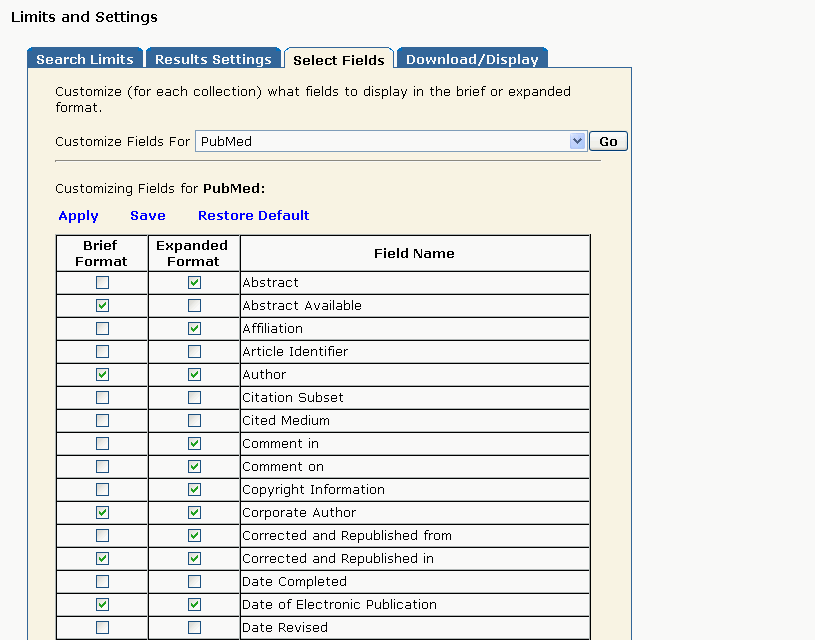
- The Select Fields option allows users to choose which fields are displayed
for brief or expanded formats for each collection.
- Use the pull down menu to select a collection and select the "Go" button.
- Select the fields to be displayed for the brief and expanded formats.
- Select the Apply or Save button before selecting the "Search" button.
- Above is the top of the Select Fields page for PubMed.
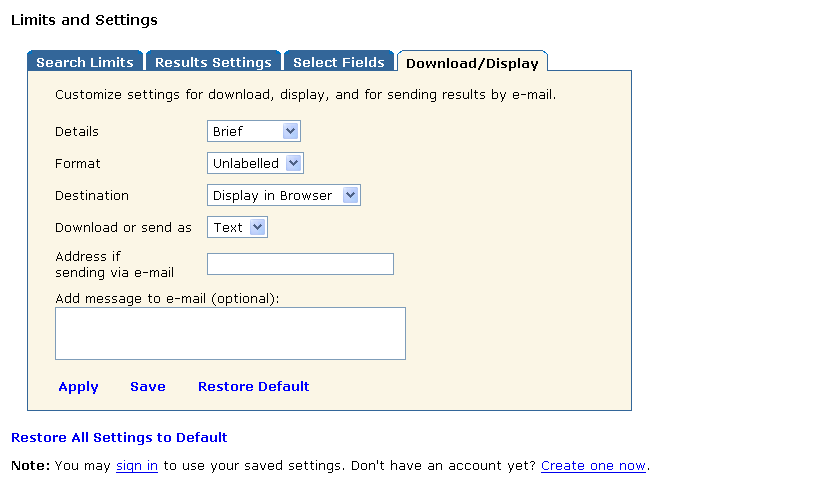
- Use the Details pull down menu to select the display format
(Brief, Expanded, Complete).
- Use the Format pull down menu to select Unlabelled, Labelled
or Export.
- Use the Destination pull down menu to select where the
items are to be downloaded or displayed. Send via e-mail is not an option
since it has a separate action.
- Use the Download or send as pull down menu to select text
or Html.
- You may enter an e-mail address in the Address if sending via e-mail
text box for the Send via e-mail option.
- You may enter a optional message in the Add message if sending via
email (optional) text box for the Send via e-mail option.
- Select the Apply or Save button before selecting the "Search" button.
- Additional information on the above options may be found in the
Download or Display section.
Results
Results Categories
In the NLM Gateway, your search terms will be searched simultaneously
in multiple retrieval systems. Results from all systems will be displayed
on the Results Summary page, broadly divided into categories.
Categories are based primarily on information format, with the exception
of consumer health. While consumer health information may potentially be
found in any category, the consumer health category highlights information
intended primarily for patients, their families and the general public.
The categories of retrieval systems and current collections within
the categories are as follows:
Category |
Collections |
Bibliographic Resources |
MEDLINE®/PubMed®,
NLM Catalog, Bookshelf, TOXLINE Subset, DART: Developmental and Reproductive
Toxicology, and Meeting Abstracts |
Consumer Health Resources |
MedlinePlus®
Health Topics, MedlinePlus Drug Information, MedlinePlus Medical Encyclopedia,
MedlinePlus Current Health News, MedlinePlus Other Resources,
ClinicalTrials.gov, DIRLINE®: Directory of Health Organizations,
Genetics Home Reference, and Household Products Database |
Other Information Resources |
HSRProj, OMIM: Online Mendelian
Inheritance in Man, HSDB: Hazardous Substances Data Bank, IRIS: Integrated
Risk Information System, ITER: International Toxicity Estimates for Risk,
GENE-TOX: Genetic Toxicology (Mutagenicity), CCRIS: Chemical
Carcinogenesis Research Information System, and Profiles in Science
|
Results Summary
When you select the "Search" button, the Gateway performs your
search and displays the Results Summary page.
- The Results Summary shows each collection name and the number
of items found.
- Error is displayed if an error is encountered in searching a particular collection.
- N/A is displayed if a search is not applicable to a particular collection.
- Select the collection name (e.g., MEDLINE/PubMed) to see the retrieved
items for that collection.
- Select Search Details to see how the Gateway
translated your search terms.
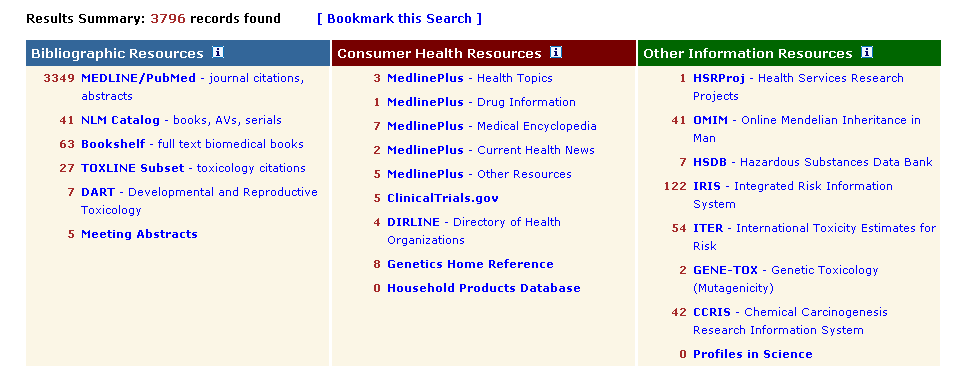
Notes:
- Search Details lets you view your search strategy as it was
translated using the Gateway's automatic term mapping and search
rules and syntax.
- Search Details contains warnings and error messages.
- Spell checker warnings are below the Results Summary line.
The user may ignore the warning, or select the "Details" link to view
a page with alternate spellings. The user may select from the list of
suggested words and rerun the search, or cancel to return to the
original results.
- Beside the Results Summary is a "Bookmark this Search" button.
To save the search terms, select the "Bookmark this Search" button.
The Bookmark this Search page will be displayed. A new browser window will open with
the Results Summary page for the search. Use the Bookmark or Favorites
feature of your Web browser to save the search, and then close the browser
window and continue with Gateway searching.
- Search results from ClinicalTrials.gov displays all trials, including
those no longer recruiting patients.
- Order of retrieved results
- CCRIS: Chemical Carcinogenesis Research Information System,
ClinicalTrials.gov, DART: Developmental and Reproductive Toxicology,
GENE-TOX: Genetic Toxicology (Mutagenicity), Genetics Home Reference,
HSDB: Hazardous Substances Data Bank, HSRProj, IRIS: Integrated Risk
Information System, ITER: International Toxicity Estimates for Risk,
all MedlinePlus collections, Meeting Abstracts,
OMIM: Online Mendelian Inheritance in Man, and TOXLINE Subset
results are displayed in relevance ranked order.
- DIRLINE: Directory of Health Organizations results are displayed in random order.
- NLM Catalog and PubMed results are displayed in descending
Entrez Date order. The Entrez Date is the date the citation
was added, so items are displayed in a "last in, first out" order.
Results Page
- To view the results for a collection from the Results Summary page,
select the collection name.

Navigation
- The Arrows and Prev/Next buttons navigate forward and backward
through the pages of results.
- The Page button allows you to go directly to a
specific page number. Enter the page number in the page number box,
and select the "Page" button.
- Use checkboxes to select individual or multiple items.
- Select:
- Email to send a number of items via e-mail.
- Download to download or display a number of items.
- Put in Locker to put selected items in your locker. All items
on the page will be put in your locker if no items have been selected.
If you are not signed in, the Gateway Sign in page will be displayed.
- Order documents to order selected items via Loansome Doc (PubMed only).
All items on the page will be ordered if no items have been selected.
- Clear check marks to erase all check marks for selected items.
- Select the title to show a fuller display for an individual item.
- A warning message ("One or more search terms were dropped. See Search
Details") is displayed on the results page if part of a user search query
is dropped, but the search is still run and results are returned to the user.
- The Related Articles link (PubMed only) retrieves a set of
journal citations closely related to the individual item.
- The Free in PMC, Free at producer site, and Free at
producer site (reg req) links (PubMed only) provide access to free
full text of an item.
-
Notes:
- Jumping hundreds of pages in some collections may
be very slow.
Display Formats
Gateway items are initially displayed in Brief Format.
The Expanded Format provides a more complete display of the item.
A table of all collections and the fields
found in the brief format and expanded format is available. See below for
an example of an expanded format for a PubMed item in two parts. Note the
Publisher Link, LinkOut, Free in PubMed Central (PMC), and Free at producer
site links. The links provide access to the full text of the article.
This option is available only with PubMed. Please note that there may be a
charge to access the text or information via the Publisher Link or LinkOut.
The PubMed expanded format may include additional information such as
abstract, MeSH terms, chemical substances, and publication types.
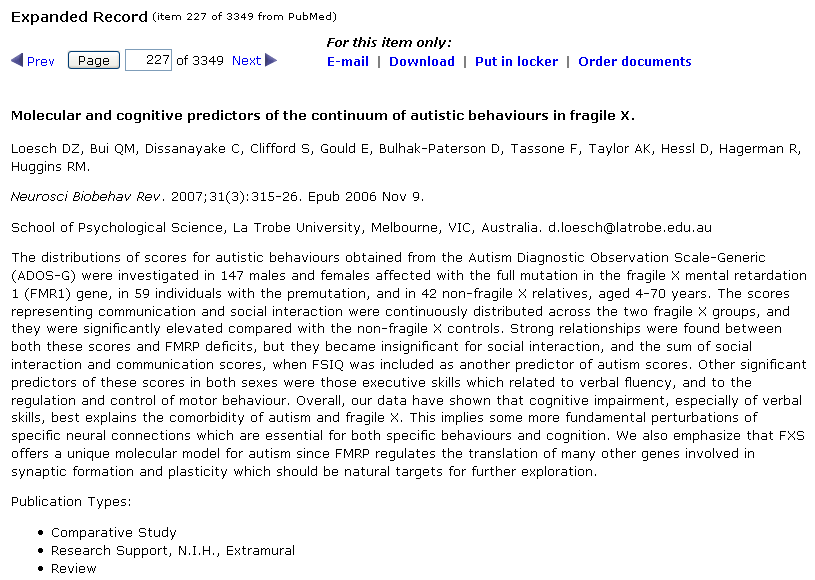
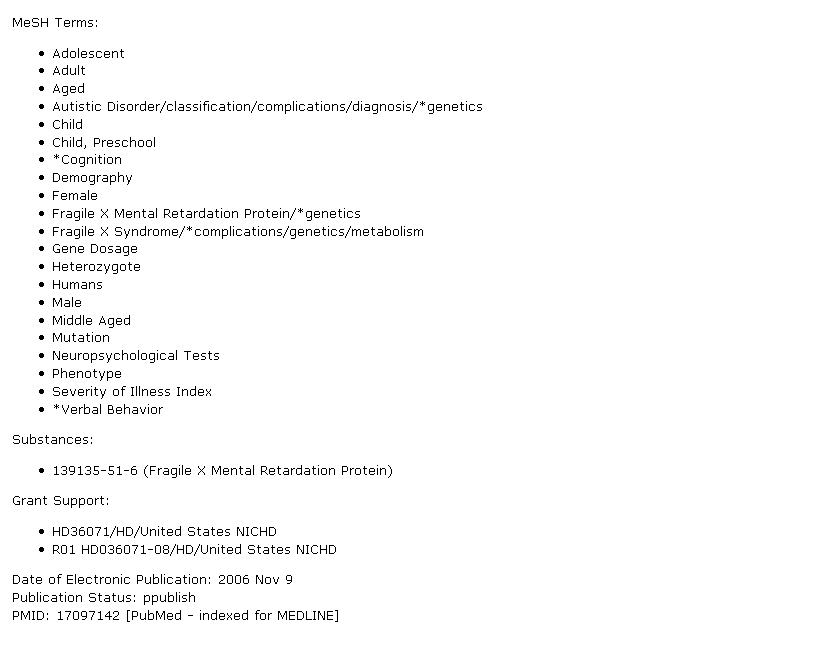

Notes:
- The Display Formats Data Elements by Collection
table
lists the fields that will be displayed
with items from each collection for both the brief and expanded formats.
- The Gateway Data Elements by Collection
table
lists all data elements and the collections in which they are found.
- You may customize the brief and expanded formats for any collection. See
Search Limits and Settings for more information.
Download/Display
- Select Download to display multiple items in the
Web browser or save items to a file.
A typical Download or Display page is shown below.
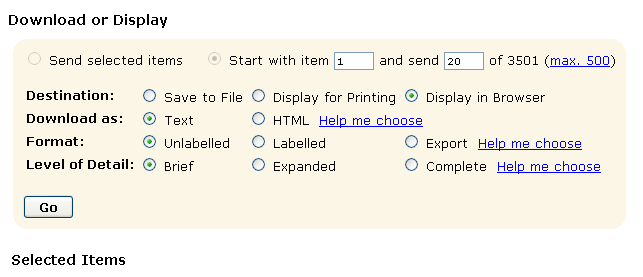
- Select the radio buttom for "Send selected items" or "Start with item".
- Selected items are at the bottom of the page.
Checked items (default) will be downloaded or displayed.
- If downloading or displaying a block of items, fill in the starting item
number and the number of items. The maximum number of items for downloading or
displaying at one time is 500. The default number of items is 20.
- Use the Destination radio buttons to select the destination for the items
to be downloaded or displayed. Choices are Save to File, Display for Printing,
and Display in Browser. The default destination is Display in Browser.
- Use the Download as radio buttons to select Text or
Html. The default is Text.
- Use the Format radio buttons to select Unlabelled, Labelled or
Export (MEDLARS tagged). The default format is Unlabelled. The labelled
format labels each field with the full field name. The export format labels
each field with the field name abbreviation. The export format is used for
importing data into bibliographic management programs.
- Use the Level of Detail radio buttons to select the display format.
Choices are Brief, Expanded, and Complete. The default is Brief.
- After you make all your selections, select the Go button to
download or display.
Notes:
- Display for Printing allows you to display your items as ASCII text
without the graphics on each page.
- Use the print function of your Web browser to print the information
displayed on your Web page.
- You can only print the information from the displayed page.
- For more information on printing, review the "How do I print my results?"
FAQ.
- The Download as option applies only to the Save to File Destination.
- Selected items displays selections from all collections and
categories.
- For more information on saving, review the "How do I save my results?"
FAQ.
- For more information on importing, review the "How do I import my results
into a bibliographic manager program?" FAQ.
Send via e-mail
- Select E-mail to display multiple items via e-mail.
A typical E-mail Search Results page is shown below.

- Enter an e-mail address. Multiple e-mail addresses should
be separated by a semicolon.
- Enter an optional message that will be displayed before the Gateway results.
- Select the radio buttom for "Send selected items" or "Start with item".
- Selected items are at the bottom of the page.
Checked items (default) will be e-mailed.
- If e-mailing a block of items, fill in the starting item number and the number of
items. The maximum number of items for e-mailing at one time is 500. The default
number of items is 20.
- Use the Send as radio buttons to select Text or
Html. The default is Text.
- Use the Format radio buttons to select Unlabelled, Labelled or
Export (MEDLARS tagged). The default format is Unlabelled. The labelled
format labels each field with the full field name. The export format labels
each field with the field name abbreviation. The export format is used for
importing data into bibliographic management programs.
- Use the Level of Detail radio buttons to select the display format.
Choices are Brief, Expanded, and Complete. The default is Brief.
- After you make all your selections, select the Send button to
send.
Document Ordering
- Please note that items may only be ordered from PubMed.
- You may order documents directly from the Results page. Use checkboxes
to select items for ordering, and select Order Documents.
- You may order items from several searches at one time. Store selected
search items for document ordering in the Locker. When you are finished
searching, access the Locker to place your document order.
- Information about the Locker may be found in the
Locker section.
- For more information on ordering documents, review the
"How do I use the Loansome Doc® document ordering system?"
FAQ.
Search History
- Use "History" on the Gateway Features bar to access the
Search History page.
- The Search History displays the search strategies and results for
the last 25 searches.
- The most recent search is on the top of the list.
- Use the "Clear History" button to clear all Search History entries.
- Use the "Delete" button to delete an individual search from the
Search History.
- Use the "View Results" button to display the Results Summary page for an
individual search. Limits for an individual search will be applied, but
the Limits box will not be set.
- You may use the Search Number in a subsequent search (e.g., #1 AND zinc).
Notes:
- The Search Number must immediately follow the pound sign (e.g., #1 AND zinc,
not # 1 and zinc).
- Once the maximum number of searches is reached, the Gateway will
remove the oldest search from the History list and add the most current search.
- The Search History is lost when you close your Web browser.
Term Finder
The Medical
Subject Headings (MeSH) comprise NLM's controlled vocabulary used
for indexing articles, for cataloging books and other holdings, and
for searching MeSH-indexed databases, including MEDLINE. MeSH
terminology provides a consistent way to retrieve information that
may use different terminology for the same concepts. MeSH is one of
dozens of vocabularies that are part of the
Unified Medical
Language System (UMLS) Metathesaurus.
- Use the "Term Finder" button on the Gateway Features bar to access the
Term Finder page.
- Use Term Finder to select terms from the MeSH vocabulary and
the UMLS Metathesaurus.
- If you enter a term that is not a valid MeSH term, the Metathesaurus
mappings will be checked and the associated MeSH term, if any, will be
displayed. If there is no associated MeSH term, a list of related concepts
will be displayed.
Below is the initial Term Finder page.

- Enter a search term in the Term Finder query box.
- Select the Go button.
- If the search term you entered is a MeSH term or is directly
mapped to a MeSH term in the ULMS Metathesaurus, the Concept Details
page will be displayed.
- If the search term you entered has multiple meanings in the
ULMS Metathesaurus, the Select a MeSH Term page will be displayed.
- Choose one of the MeSH Terms displayed on the page.
- The Concept Details page will be displayed for the MeSH term you chose.

The Concept Details page is displayed for Common Cold.
It is shown below in three parts:
Top portion of Concept Details page

- Note the definition for the concept Common Cold.
- The note "no definition available for this record"
will be displayed if a concept definition is not available.
- Use the Related Concepts button to view a list of concepts
related to Common Cold.
- Use the View MeSH Information button for additional details
about the MeSH term.
- Use the Add to Search button and the Connector pull
down menu to add this term to your search strategy.
- Use the Main point of item checkbox to limit the term to
the main point of the article.
- Use the Do not explode this term checkbox to turn off
automatic explosion in PubMed and NLM Catalog.
Note: The explosion of a MeSH term refers to the inclusion
of more specific MeSH terms indented under it in the MeSH hierarchy.
MeSH terms are arranged hierarchically by subject categories
with more specific terms arranged beneath broader terms.
MeSH organizes its descriptors in a hierarchical structure (MeSH Trees)
so that broad searches may include items indexed more narrowly.
More information on the structure of MeSH is available in the
Medical Subject Headings (MeSH) Fact Sheet.
Information on subheadings may be found on the
Qualifiers page.
Middle portion of Concept Details page
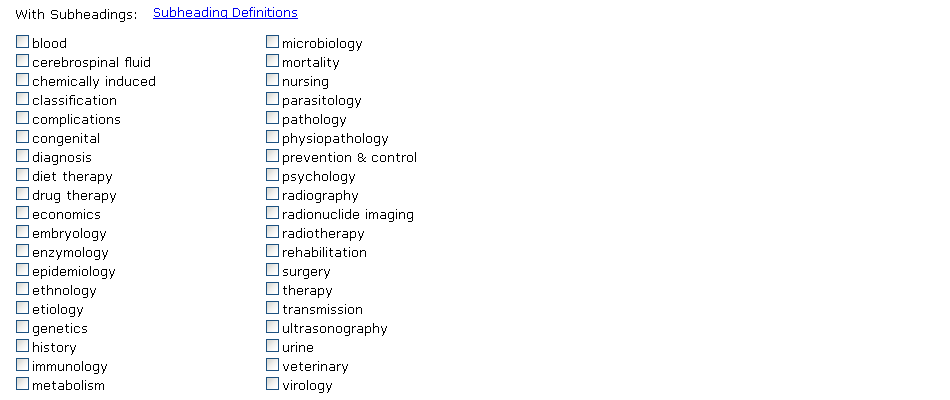
- Use this section of the Concept Details page to add subheadings
to the term.
- All allowable subheadings for the MeSH term are displayed.
- Select the checkbox next to each subheading you want to attach to the term.
You may select as many subheadings as you wish.
- If multiple subheadings are entered for one MeSH term,
the subheadings are ORed together.
- Use the Subheadings Definitions link if you would like to check a
subheading definition.
Bottom portion of Concept Details page
The last section of the Concept Details page shows the MeSH tree(s)
in which the term is found.
- Select any concept in the MeSH tree to display the Concept Details page.
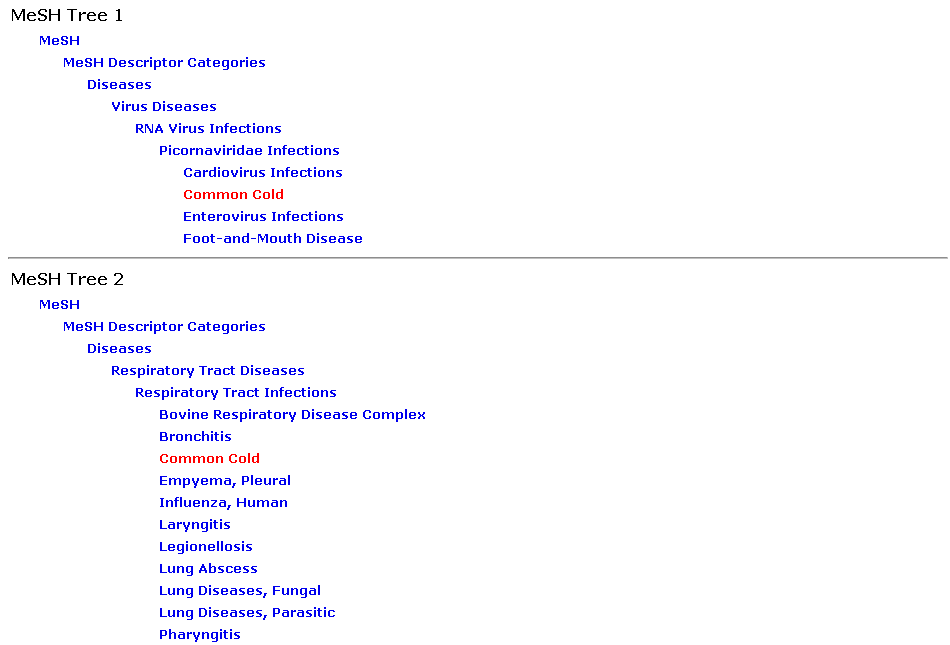
Locker
- Select "MyLocker" on the Gateway Features bar to access the Locker.
- Use the Locker to permanently store selected search items for printing,
downloading or document ordering.
- You must sign in to use the Locker.
Sign in requires a User ID and password. Registration is free.
- After you select items from the Results page, select the Put in
Locker button.
- Gateway confirms that the items are added to your Locker
with the following message:

- Select Locker on the Features Bar to view the
contents of your Locker.
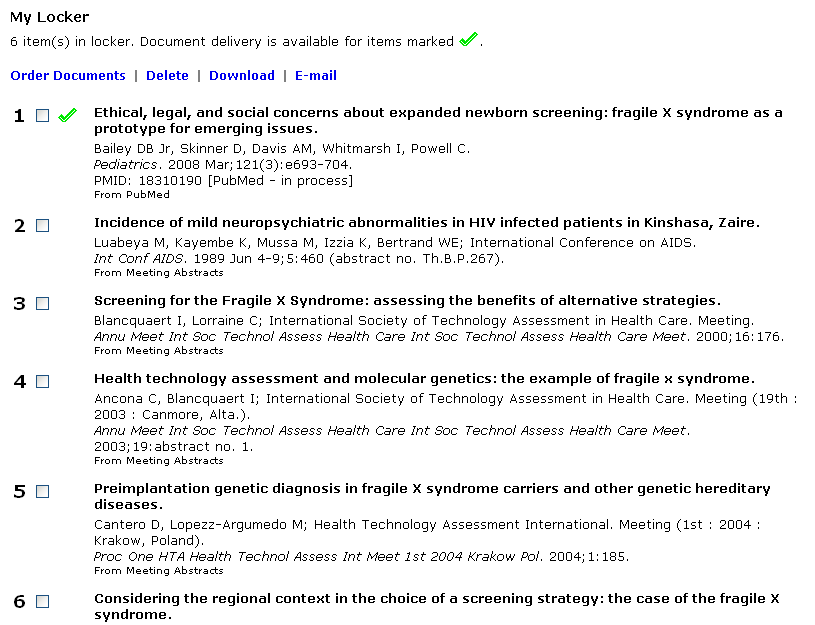
- From the Select an action pull down menu, select:
- Order Documents to order documents through Loansome Doc.
Note the green check which indicates that document delivery
is available for marked items.
- Delete to delete all the items in your Locker.
- Delete to delete selected items from your Locker.
- Download or Display to download
or display items in your Locker.
Notes:
- Items in your locker are sorted by Collection.
- If an item is already in your locker, it will not be added again.
- Items remain in the locker until you delete them.
- There is a limit of five hundred (500) items that may be stored in
the locker.
- When you sign in to use your locker, your permanent limits and settings will not be
used unless you select the "use my limits/settings" checkbox on the
Sign in page.
Sign in
- When you select "MyLocker" on the Gateway Features bar, the Gateway
Sign in page will be displayed. The Sign in page is also available from the
Limits and Settings page.

- To sign in, enter your User ID and password. If you want to use your
permanent limits and settings, make sure the "Use my limits/settings" checkbox is checked.
Select the "Sign in" button.
- Your User ID and password are not case sensitive, so the User ID
JaneDoe is the same as the User ID JANEDOE or janedoe.
- Users are asked once to provide a question and its answer that is
easy to remember. If you forget your password, the question is displayed
when you select the "Forgot Password" button.
Enter the answer and select the Go button. If the answer is correct,
the password will be displayed on the Sign in page.
- If you do not have a User ID, select the Create one now button.
- If you have forgotten your password, enter your User ID and select the
Forgot Password button.
- If you have forgotten your password and you have not provided a
question and answer, you must contact NLM Customer Service
(gateway@nlm.nih.gov).
- You will remain signed in indefinitely, as long as you are actively
using the Gateway. After one hour of inactivity, you will automatically
be signed out of the Gateway.
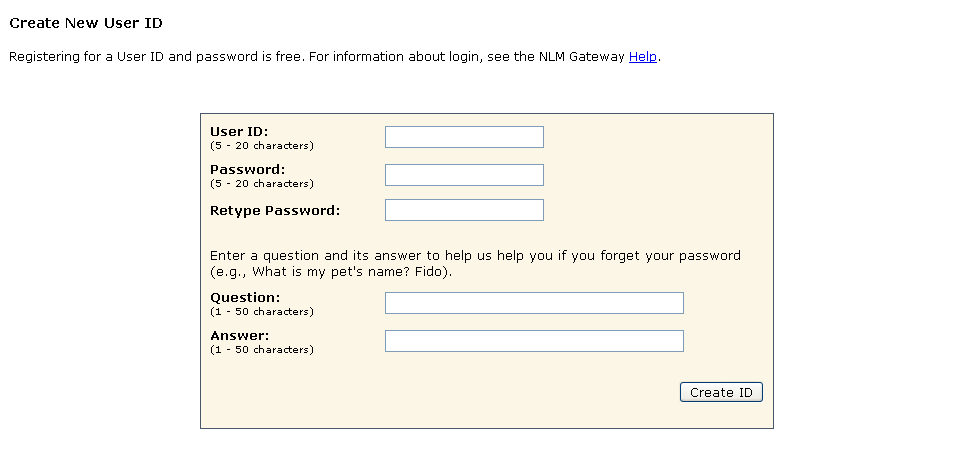
- To create an account, you must provide a User ID, password,
question and answer.
- You are asked to provide a question and its answer that is
easy to remember. If you forget your password, the question is
displayed when you select the "Forgot Password" button. Enter
the answer and select the Go button. If the answer is correct,
the password will be displayed on the Sign in page.
- Your User ID and password may be five to twenty alphanumeric
characters in length.
- Your User ID may contain letters, numbers, or a combination
of letters and numbers.
- Your password may contain letters, numbers, special characters,
or any combination of letters, numbers, and special characters.
- Your User ID and password are not case sensitive, so the
User ID JaneDoe is the same as the User ID JANEDOE or janedoe.
- User IDs and passwords must be unique. If you enter an User ID
or password that already exists, you will be asked to enter an
alternate User ID or password.
- Your question and answer may be one to fifty alphanumeric characters
in length.
- Your question and answer may contain letters, numbers, special characters,
or any combination of letters, numbers, and special characters.

- If you forget your password, the Password Hint page will be displayed
with your User ID and your question.
- Enter the answer and select the Go button.
- If the answer is correct, the password will be displayed on the
Sign in page.
For More Assistance
Customer Support
If you need more assistance, please select the "Contact Us"
button to the right of the query box or send an e-mail to
gateway@nlm.nih.gov.
You may also contact NLM Customer Service
via phone.
NLM Publications on the Gateway
Gateway Training
Linking to the Gateway
You may link to the National Library of Medicine's Gateway search
service without obtaining permission. However, if you wish to point a
robot or spider at the NLM Gateway or create an application that will
create a heavy load on the Gateway system, please
contact us first.
We will be happy to work with you to evaluate your individual situation.
System Configuration
The Gateway is written in Java. It uses Common Object Request
Broker Architecture (CORBA), an open, vendor-independent architecture
and infrastructure that computer applications use to work together
over networks. The Gateway uses eXtensible Markup Language (XML)
for internal and external messaging. Cookies are not utilized in the
Gateway. Javascript is only used for system enhancements, and all
features of the Gateway will work without Javascript. The NLM Gateway
runs on a "server farm" of four Dell servers running the Linux operating
system, and two Sun Enterprise 3500 midrange servers. Additional servers can
easily be added to the "server farm" as the use of the Gateway increases
over time. With rare exceptions, the Gateway is available 24 hours
a day, seven days a week.
|